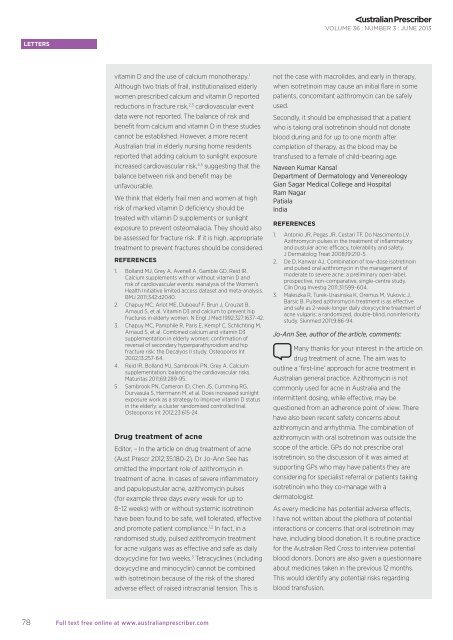download the full PDF issue - Australian Prescriber
download the full PDF issue - Australian Prescriber
download the full PDF issue - Australian Prescriber
Create successful ePaper yourself
Turn your PDF publications into a flip-book with our unique Google optimized e-Paper software.
VOLUME 36 : NUMBER 3 : JUNE 2013<br />
LETTERS<br />
vitamin D and <strong>the</strong> use of calcium mono<strong>the</strong>rapy. 1<br />
Although two trials of frail, institutionalised elderly<br />
women prescribed calcium and vitamin D reported<br />
reductions in fracture risk, 2,3 cardiovascular event<br />
data were not reported. The balance of risk and<br />
benefit from calcium and vitamin D in <strong>the</strong>se studies<br />
cannot be established. However, a more recent<br />
<strong>Australian</strong> trial in elderly nursing home residents<br />
reported that adding calcium to sunlight exposure<br />
increased cardiovascular risk, 4,5 suggesting that <strong>the</strong><br />
balance between risk and benefit may be<br />
unfavourable.<br />
We think that elderly frail men and women at high<br />
risk of marked vitamin D deficiency should be<br />
treated with vitamin D supplements or sunlight<br />
exposure to prevent osteomalacia. They should also<br />
be assessed for fracture risk. If it is high, appropriate<br />
treatment to prevent fractures should be considered.<br />
REFERENCES<br />
1. Bolland MJ, Grey A, Avenell A, Gamble GD, Reid IR.<br />
Calcium supplements with or without vitamin D and<br />
risk of cardiovascular events: reanalysis of <strong>the</strong> Women’s<br />
Health Initiative limited access dataset and meta-analysis.<br />
BMJ 2011;342:d2040.<br />
2. Chapuy MC, Arlot ME, Duboeuf F, Brun J, Crouzet B,<br />
Arnaud S, et al. Vitamin D3 and calcium to prevent hip<br />
fractures in elderly women. N Engl J Med 1992;327:1637-42.<br />
3. Chapuy MC, Pamphile R, Paris E, Kempf C, Schlichting M,<br />
Arnaud S, et al. Combined calcium and vitamin D3<br />
supplementation in elderly women: confirmation of<br />
reversal of secondary hyperparathyroidism and hip<br />
fracture risk: <strong>the</strong> Decalyos II study. Osteoporos Int<br />
2002;13:257-64.<br />
4. Reid IR, Bolland MJ, Sambrook PN, Grey A. Calcium<br />
supplementation: balancing <strong>the</strong> cardiovascular risks.<br />
Maturitas 2011;69:289-95.<br />
5. Sambrook PN, Cameron ID, Chen JS, Cumming RG,<br />
Durvasula S, Herrmann M, et al. Does increased sunlight<br />
exposure work as a strategy to improve vitamin D status<br />
in <strong>the</strong> elderly: a cluster randomised controlled trial.<br />
Osteoporos Int 2012;23:615-24.<br />
Drug treatment of acne<br />
Editor, – In <strong>the</strong> article on drug treatment of acne<br />
(Aust Prescr 2012;35:180-2), Dr Jo-Ann See has<br />
omitted <strong>the</strong> important role of azithromycin in<br />
treatment of acne. In cases of severe inflammatory<br />
and papulopustular acne, azithromycin pulses<br />
(for example three days every week for up to<br />
8–12 weeks) with or without systemic isotretinoin<br />
have been found to be safe, well tolerated, effective<br />
and promote patient compliance. 1,2 In fact, in a<br />
randomised study, pulsed azithromycin treatment<br />
for acne vulgaris was as effective and safe as daily<br />
doxycycline for two weeks. 3 Tetracyclines (including<br />
doxycycline and minocyclin) cannot be combined<br />
with isotretinoin because of <strong>the</strong> risk of <strong>the</strong> shared<br />
adverse effect of raised intracranial tension. This is<br />
not <strong>the</strong> case with macrolides, and early in <strong>the</strong>rapy,<br />
when isotretinoin may cause an initial flare in some<br />
patients, concomitant azithromycin can be safely<br />
used.<br />
Secondly, it should be emphasised that a patient<br />
who is taking oral isotretinoin should not donate<br />
blood during and for up to one month after<br />
completion of <strong>the</strong>rapy, as <strong>the</strong> blood may be<br />
transfused to a female of child-bearing age.<br />
Naveen Kumar Kansal<br />
Department of Dermatology and Venereology<br />
Gian Sagar Medical College and Hospital<br />
Ram Nagar<br />
Patiala<br />
India<br />
REFERENCES<br />
1. Antonio JR, Pegas JR, Cestari TF, Do Nascimento LV.<br />
Azithromycin pulses in <strong>the</strong> treatment of inflammatory<br />
and pustular acne: efficacy, tolerability and safety.<br />
J Dermatolog Treat 2008;19:210-5.<br />
2. De D, Kanwar AJ. Combination of low-dose isotretinoin<br />
and pulsed oral azithromycin in <strong>the</strong> management of<br />
moderate to severe acne: a preliminary open-label,<br />
prospective, non-comparative, single-centre study.<br />
Clin Drug Investig 2011;31:599-604.<br />
3. Maleszka R, Turek-Urasinska K, Oremus M, Vukovic J,<br />
Barsic B. Pulsed azithromycin treatment is as effective<br />
and safe as 2-week-longer daily doxycycline treatment of<br />
acne vulgaris: a randomized, double-blind, noninferiority<br />
study. Skinmed 2011;9:86-94.<br />
Jo-Ann See, author of <strong>the</strong> article, comments:<br />
Many thanks for your interest in <strong>the</strong> article on<br />
drug treatment of acne. The aim was to<br />
outline a ‘first-line’ approach for acne treatment in<br />
<strong>Australian</strong> general practice. Azithromycin is not<br />
commonly used for acne in Australia and <strong>the</strong><br />
intermittent dosing, while effective, may be<br />
questioned from an adherence point of view. There<br />
have also been recent safety concerns about<br />
azithromycin and arrhythmia. The combination of<br />
azithromycin with oral isotretinoin was outside <strong>the</strong><br />
scope of <strong>the</strong> article. GPs do not prescribe oral<br />
isotretinoin, so <strong>the</strong> discussion of it was aimed at<br />
supporting GPs who may have patients <strong>the</strong>y are<br />
considering for specialist referral or patients taking<br />
isotretinoin who <strong>the</strong>y co-manage with a<br />
dermatologist.<br />
As every medicine has potential adverse effects,<br />
I have not written about <strong>the</strong> plethora of potential<br />
interactions or concerns that oral isotretinoin may<br />
have, including blood donation. It is routine practice<br />
for <strong>the</strong> <strong>Australian</strong> Red Cross to interview potential<br />
blood donors. Donors are also given a questionnaire<br />
about medicines taken in <strong>the</strong> previous 12 months.<br />
This would identify any potential risks regarding<br />
blood transfusion.<br />
78 Full text free online at www.australianprescriber.com
















